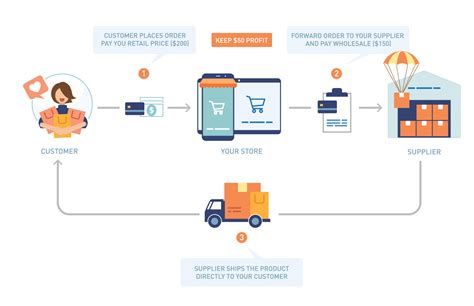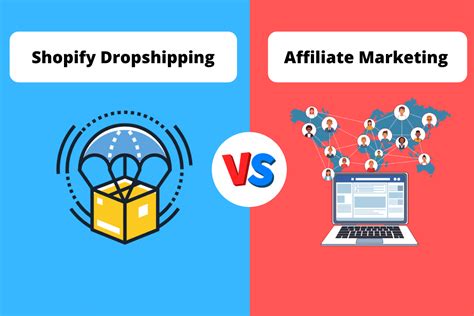Dropshipping has emerged as a highly popular and lucrative business model in the e-commerce industry, allowing entrepreneurs to start an online store without holding any inventory. This approach has revolutionized the way businesses operate, offering a cost-effective and efficient method to reach a wider audience. The concept of dropshipping is straightforward: an online store markets and sells products to customers, but instead of storing and shipping the products themselves, they partner with a supplier who handles the inventory and shipping. This arrangement eliminates the need for the online store to invest in inventory upfront, significantly reducing the financial risks and operational complexities associated with traditional retail models.
The appeal of dropshipping can be attributed to its numerous benefits, including low startup costs, minimal risk, and the potential for high returns. However, like any business venture, dropshipping also comes with its set of challenges, such as managing supplier relationships, ensuring product quality, and maintaining customer satisfaction. Despite these challenges, many entrepreneurs and businesses have found success with dropshipping, leveraging its flexibility and scalability to build profitable online stores. In this article, we will delve into five ways dropshipping can be utilized to build a successful e-commerce business, exploring strategies for selecting the right products, managing suppliers, optimizing marketing efforts, and enhancing customer experience.
Key Points
- Understanding the dropshipping model and its benefits for e-commerce businesses
- Identifying profitable products and niches for dropshipping
- Strategies for managing supplier relationships and ensuring product quality
- Optimizing marketing efforts for dropshipping businesses
- Enhancing customer experience and building brand loyalty in dropshipping
Understanding the Dropshipping Model

The dropshipping model is based on a simple yet effective concept: selling products without holding any inventory. When a customer places an order, the online store forwards the order and customer details to the supplier, who then ships the product directly to the customer. This model eliminates the need for the online store to invest in inventory, reducing the initial capital required to start the business. Moreover, it allows businesses to focus on marketing and sales, leaving the logistics and inventory management to the suppliers.
One of the primary advantages of dropshipping is its low barrier to entry. With minimal upfront costs, entrepreneurs can start an online store and begin selling products quickly. This model also offers flexibility in terms of product offerings, as businesses can easily add or remove products from their catalog without having to worry about inventory storage and management. However, the success of a dropshipping business heavily depends on the ability to find reliable suppliers and to market products effectively to potential customers.
Identifying Profitable Products and Niches
Identifying the right products and niches is crucial for the success of a dropshipping business. The ideal products should have a high demand, relatively low competition, and a decent profit margin. Conducting thorough market research is essential to find such products. Tools like Google Trends, Amazon Best Sellers, and social media platforms can provide insights into current consumer trends and preferences. Additionally, analyzing competitors and understanding their strengths and weaknesses can help in making informed decisions about product selection.
A profitable niche could be anything from electronics and fashion to home decor and outdoor gear, depending on the target audience and market trends. It's also important to consider the product's price point, shipping costs, and the potential for upselling or cross-selling. For instance, products with a higher price point might offer better profit margins but could also deter price-sensitive customers. Balancing these factors is key to selecting products that will attract and retain customers.
| Product Category | Average Price Point | Shipping Cost | Potential Profit Margin |
|---|---|---|---|
| Electronics | $50-$100 | $10-$20 | 15%-25% |
| Fashion | $20-$50 | $5-$15 | 20%-30% |
| Home Decor | $30-$70 | $15-$30 | 25%-35% |

Managing Supplier Relationships

Building strong relationships with suppliers is vital for the success of a dropshipping business. A reliable supplier ensures that products are shipped on time, are of good quality, and meet customer expectations. When selecting suppliers, it’s essential to consider factors such as product quality, shipping times, communication, and pricing. Suppliers can be found through directories like SaleHoo or Worldwide Brands, or by attending trade shows and industry events.
Effective communication with suppliers is key to resolving any issues that may arise, such as delays in shipping or product defects. Regularly updating suppliers about sales and forecasting demand can help them prepare and improve their services. Moreover, having a backup supplier for critical products can mitigate risks associated with supply chain disruptions.
Optimizing Marketing Efforts
Marketing plays a crucial role in the success of a dropshipping business, as it directly impacts sales and revenue. With the rise of digital marketing, there are numerous channels and strategies that businesses can leverage to reach their target audience. Social media platforms like Facebook, Instagram, and TikTok offer powerful advertising tools that can help businesses target specific demographics and interests. Email marketing, content marketing, and influencer marketing are also effective strategies for building brand awareness and driving sales.
Understanding the target audience is fundamental to creating effective marketing campaigns. By analyzing customer data and feedback, businesses can tailor their marketing efforts to meet the needs and preferences of their audience. Additionally, leveraging user-generated content and customer testimonials can enhance brand credibility and trust among potential customers.
Enhancing Customer Experience
Customer experience is a critical factor in building a loyal customer base and driving repeat business. In dropshipping, where businesses do not directly handle products, ensuring timely shipping, providing accurate product information, and offering excellent customer service are essential. Implementing a robust tracking system allows customers to monitor their orders, reducing anxiety and improving satisfaction. Moreover, having a clear and fair return policy can mitigate the risk of customer dissatisfaction.
Engaging with customers through social media and email newsletters can also help in building a community around the brand. Sharing tips, trends, and behind-the-scenes content can make customers feel valued and connected to the brand. By prioritizing customer experience and continually gathering feedback, businesses can identify areas for improvement and implement changes to enhance overall customer satisfaction.
What are the initial steps to starting a dropshipping business?
+The initial steps include researching and selecting a niche, finding reliable suppliers, setting up an online store, and developing a marketing strategy. It's also crucial to understand the legal and financial aspects of running a business.
How do I manage product quality in dropshipping?
+Managing product quality involves selecting reliable suppliers, ordering sample products, and monitoring customer feedback. Regular communication with suppliers and having a system for handling defects or issues is also essential.
What marketing strategies are most effective for dropshipping businesses?
+Effective marketing strategies include social media advertising, email marketing, content marketing, and influencer marketing. The key is to understand the target audience and tailor the marketing efforts accordingly.
In conclusion, dropshipping offers a viable and attractive business model for entrepreneurs looking to venture into e-commerce. By understanding the dropshipping model, identifying profitable products, managing supplier relationships effectively, optimizing marketing efforts, and enhancing customer experience, businesses can build a successful and sustainable dropshipping operation. As with any business, success in dropshipping requires dedication, continuous learning, and adaptation to market trends and consumer preferences. With the right strategies and mindset, entrepreneurs can leverage dropshipping to achieve their business goals and thrive in the competitive e-commerce landscape.



